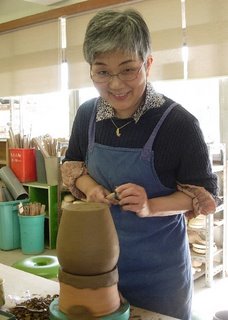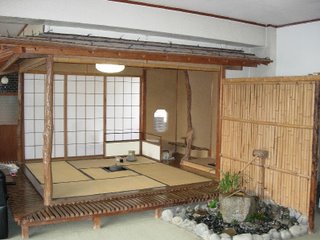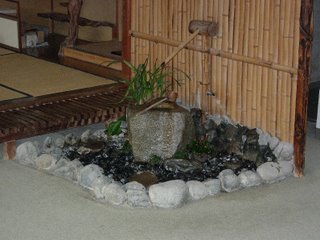During the week I go to the Nippon Tougei Club, a pottery school in Harajuku in Tokyo.
I bike to the Kamakura station and then take the train. Last time, it only took me 55 minutes to arrive in Harajuku. There are so many people taking the train. I'm still amazed about the masses of people walking in the stations from one train to another. They walk everywhere, but they wait in neat lines for the trains and step politely aside to first let the people out and then everybody goes in and push and push so everybody fits. Funny contrasts.
I work in 2 different groups and started to make "tebineri", hand pinched "Chawan", teabowls for the "Chaji", tea ceremony.
I use Shigaraki clay, a special clay from the Shiga Prefecture of Japan. Shigaraki Ware is high-fired unglazed ware famous for its ash deposits and distinctive forms. Shigaraki pottery is thought to have begun in the waning years of the Kamakura period (1192-1333). Shigaraki wares were originally daily utensils. Not until the teamasters of the Muromachi (1336-1568) and Momoyama periods (1568-1603) favored these natural wares, did they develop into one's of Japan's important ceramic styles.

The executive director is Naoko Kurihara-san. I work with her.
Their website is: www.tougei-club.com .

The potters room.

The gas and electric kilns.

There is also an authentic "Chashitsu", tearoom, where they
hold "Chaji", tea ceremonies.

Next to the teahouse is the "Tsukubai", stone basin, where the "Teishu", house master, by taking a laddle of water, purifies his hands and mouth before he welcomes his guests.
I bike to the Kamakura station and then take the train. Last time, it only took me 55 minutes to arrive in Harajuku. There are so many people taking the train. I'm still amazed about the masses of people walking in the stations from one train to another. They walk everywhere, but they wait in neat lines for the trains and step politely aside to first let the people out and then everybody goes in and push and push so everybody fits. Funny contrasts.
I work in 2 different groups and started to make "tebineri", hand pinched "Chawan", teabowls for the "Chaji", tea ceremony.
I use Shigaraki clay, a special clay from the Shiga Prefecture of Japan. Shigaraki Ware is high-fired unglazed ware famous for its ash deposits and distinctive forms. Shigaraki pottery is thought to have begun in the waning years of the Kamakura period (1192-1333). Shigaraki wares were originally daily utensils. Not until the teamasters of the Muromachi (1336-1568) and Momoyama periods (1568-1603) favored these natural wares, did they develop into one's of Japan's important ceramic styles.

The executive director is Naoko Kurihara-san. I work with her.
Their website is: www.tougei-club.com .

The potters room.

The gas and electric kilns.

There is also an authentic "Chashitsu", tearoom, where they
hold "Chaji", tea ceremonies.

Next to the teahouse is the "Tsukubai", stone basin, where the "Teishu", house master, by taking a laddle of water, purifies his hands and mouth before he welcomes his guests.


0 Comments:
Post a Comment
<< Home